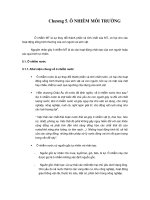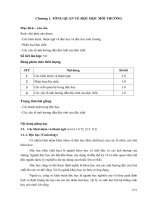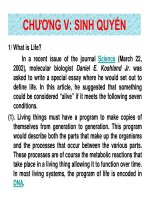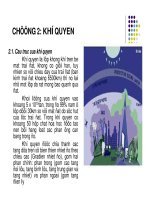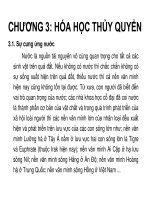bài giảng hóa học môi trường chương 5 sinh quyển
Bạn đang xem bản rút gọn của tài liệu. Xem và tải ngay bản đầy đủ của tài liệu tại đây (450.76 KB, 24 trang )
CHƯƠNG V: SINH QUYỂN
1/ What is Life?
In a recent issue of the journal Science (March 22,
2002), molecular biologist Daniel E. Koshland Jr. was
asked to write a special essay where he would set out to
define life. In this article, he suggested that something
could be considered “alive” if it meets the following seven
conditions.
(1). Living things must have a program to make copies of
themselves from generation to generation. This program
would describe both the parts that make up the organisms
and the processes that occur between the various parts.
These processes are of course the metabolic reactions that
take place in a living thing allowing it to function over time.
In most living systems, the program of life is encoded in
DNA.
(2). Life adapts (thích nghi) and evolves (tiến hóa) in step
with external changes in the environment. This process
is directly connected to life’s program through mutation
(sự đột biến) and natural selection. This condition
allows life-forms to be optimized for gradual changes in
the environment.
(3). Organisms tend to be complex, highly organized, and
most importantly have compartmentalized (chia thành
ngăn) structures. Chemicals found within their bodies
are synthesized through metabolic processes into
structures that have specific purposes. Cells and their
various organelles (cơ quan tế bào) are examples of
such structures. Cells are also the basic functioning
unit of life. In multi-cellular organisms, cells are often
organized into organs to create higher levels of
complexity and function.
• (4). Living things have the ability to take energy
from their environment and change it from one form
to another. This energy is usually used to facilitate
their growth and reproduction. We call the process
that allows for this facilitation (sự thuận lợi)
metabolism.
• (5). Organisms have regeneration (sự tái sinh)
systems that replace parts of themselves that are
subject to wear and tear. This regeneration can be
partial or it can involve the complete replacement of
the organism. Complete replacement is necessary
because partial replacements cannot stop the
unavoidable decline in the functioning state of the
entire living system over time. In other words, all
organisms degrade into a final non-functioning
state we call death.
• (6). Living creatures respond to
environmental stimuli through feedback
mechanisms. Cues from the environment
can cause organisms to react through
behavior, metabolism, and physiological
change. Further, responses to stimuli
generally act to increase a creature’s
chance for day-to-day survival.
• (7). Organisms are able to maintain
numerous metabolic reactions even in a
single instance in time. Living things also
keep each of these reactions separated
from each other.
2/ Origin of Life
• The Sun and its planets formed between 5 and 4.6 billion years ago as
matter in our solar system began to coalesce because of gravity. By
about 3.9 billion years ago, the Earth had an atmosphere that contained
the right mix of hydrogen, oxygen, carbon, and nitrogen to allow for the
creation of life. Scientists believe that the energy from heat, lightning, or
radioactive elements caused the formation of complex proteins and
nucleic acids into strands of replicating genetic code. These molecules
then organized and evolved to form the first simple forms of life. At 3.8
billion years ago, conditions became right for the fossilization of the Earth's
early cellular life forms. These fossilized cells resemble present day
cyanobacteria. Such cells are known as prokaryotes. Prokaryote cells
are very simple, containing few specialized cellular structures and their
DNA is not surrounded by a membranous envelope. The more complex
cells of animals and plants, known as eukaryotes, first showed up about
2.1 billion year ago. Eukaryotes have a membrane-bound nucleus and
many specialized structures located within their cell boundary. By 680
million years ago, eukaryotic cells were beginning to organize themselves
into multicellular organisms. Starting at about 570 million years ago an
enormous diversification of multicellular life occurred known as the
Cambrian explosion. During this period all but one modern phylum of
animal life made its first appearance on the Earth. Figure 9a-1 describes
the approximate time of origin of the Earth' s major groups of plants and
animals.
Figure 9a-1: Important events in the evolution of life. Dates for many of the events
shown are based on fossil evidence.
Figure 9a-2: This fish fossil from Wapiti Lake in British Columbia, Canada was alive during
the geologic period known as the Triassic (208-245 million yrs BP). Fish first appear on
our planet during the Ordovician Period about 500 million years ago.
h). Species Diversity and Biodiversity- các loại đdsh
Table 9h-1: Major extinction events during the Phanerozoic.
Date of the Extinction Event
Percent
Species Lost
Species Affected
65 Million Years Ago
(Cretaceous)
85%
Dinosaurs, plants (except ferns and
seed bearing plants), marine
vertebrates and invertebrates. Most
mammals, birds, turtles, crocodiles,
lizards, snakes, and amphibians were
unaffected.
213 Million Years Ago
(Triassic)
44% Marine vertebrates and invertebrates.
248 Million Years Ago
(Permian)
75-95% Marine vertebrates and invertebrates.
380 Million Years Ago
(Devonian)
70% Marine invertebrates.
450-440 Million Years Ago
(Ordovician)
50% Marine invertebrates.
• Scientists developed the notion of biodiversity to overcome some of the
difficulties of species concept. To accomplish this task, biodiversity describes the
diversity of life at the following three biological levels:
• Genetic Level or Genetic Diversity - Genetic diversity refers to the total
number of genetic characteristics expressed and recessed in all of the
individuals that comprise a particular species
• Species Level or Species Diversity - Species diversity is the number of
different species of living things living in an area. As mentioned above, a species
is a group of plants or animals that are similar and able to breed and produce
viable offspring under natural conditions.
• Ecosystem Level or Ecosystem Diversity - Ecosystem diversity is the
variation of habitats, community types, and abiotic environments present in a
given area. An ecosystem consists of all living and non-living things in a given
area that interact with one another.
• The biodiversity found on Earth today is the product of 3.5 billion years of
evolution. In fact, the Earth supports more biodiversity today than in any other
period in history. However, much of this biodiversity is now facing the threat of
extinction because of the actions of humans
Figure 9i-1: Succession of plant species on abandoned fields in North Carolina.
Pioneer species consist of a variety of annual plants. This successional stage is then
followed by communities of perennials and grasses, shrubs, softwood trees and shrubs,
and finally hardwood trees and shrubs. This succession takes about 120 years to go
from the pioneer stage to the climax community.
Abandoned Field to Oak Forest
j). Introduction to the Ecosystem Concept (khái niệm)
- Major Components of Ecosystems
• Ecosystems are composed of a variety of abiotic and biotic (vô sinh và
hữu sinh) components that function in an interrelated fashion. Some of
the more important components are: soil, atmosphere, radiation from
the Sun, water, and living organisms.
• Soils are much more complex than simple sediments. They contain a
mixture of weathered rock fragments, highly altered soil mineral particles,
organic matter, and living organisms. Soils provide nutrients, water, a
home, and a structural growing medium for organisms. The vegetation
found growing on top of a soil is closely linked to this component of an
ecosystem through nutrient cycling.
• The atmosphere provides organisms found within ecosystems with
carbon dioxide for photosynthesis and oxygen for respiration. The
processes of evaporation, transpiration, and precipitation cycle water
between the atmosphere and the Earth's surface.
• Solar radiation is used in ecosystems to heat the atmosphere and to evaporate
and transpire water into the atmosphere. Sunlight is also necessary for
photosynthesis. Photosynthesis provides the energy for plant growth and
metabolism, and the organic food for other forms of life.
• Most living tissue is composed of a very high percentage of water, up to and even
exceeding 90%. The protoplasm of a very few cells can survive if their water
content drops below 10%, and most are killed if it is less than 30-50%. Water is
the medium by which mineral nutrients enter and are translocated in plants. It is
also necessary for the maintenance of leaf turgidity and is required for
photosynthetic chemical reactions. Plants and animals receive their water from
the Earth's surface and soil. The original source of this water is precipitation from
the atmosphere.
• Ecosystems are composed of a variety of living organisms that can be classified
as producers, consumers, or decomposers. Producers or autotrophs, are
organisms that can manufacture the organic compounds they use as sources of
energy and nutrients. Most producers are green plants that can manufacture
their food through the process of photosynthesis. Consumers or heterotrophs
get their energy and nutrients by feeding directly or indirectly on producers. We
can distinguish two main types of consumers. Herbivores are consumers that eat
plants for their energy and nutrients. Organisms that feed on herbivores are called
carnivores. Carnivores can also consume other carnivores. Plants and animals
supply organic matter to the soil system through shed tissues and death.
Consumer organisms that feed on this organic matter, or detritus, are known as
detritivores or decomposers. The organic matter that is consumed by the
detritivores is eventually converted back into inorganic nutrients in the soil. These
nutrients can then be used by plants for the production of organic compounds.
• The following graphical model describes the major ecosystem components and
their interrelationships (Figure 9j-1).
Figure 9j-1: Relationships within an ecosystem
Động vật ăn cỏ
Động vật ăn thịt
Energy and Matter Flow in Ecosystems
Figure 9j-2: Inputs and outputs of energy and matter in a typical ecosystem
(l). Primary Productivity of Plants
Figure 9l-1: Inputs and outputs of the photosynthetic process.
6CO2 + 6H2O + light energy >>> C6H12O6 + 6O2
Table 9l-1: Average annual Net Primary
Productivity of the Earth's major biomes.
Ecosystem Type
Net Primary Productivity
(kilocalories/meter
-2
/year)
Tropical Rain Forest 9000
Estuary 9000
Swamps and Marshes 9000
Savanna 3000
Deciduous Temperate Forest 6000
Boreal Forest 3500
Temperate Grassland 2000
Polar Tundra 600
Desert < 200
p). Biogeochemical Cycling: Inputs and Outputs of
Nutrients to Ecosystems
• The patterns of cycling nutrients in the biosphere involves both biotic
and abiotic chemical reactions. Understanding the biogeochemical
cycle of any biologically important element requires the knowledge of
chemical processes that operate in the biosphere, lithosphere,
atmosphere, and hydrosphere.
• The biogeochemical cycles of all elements used by life have both an
organic and an inorganic phase. For most of these nutrients, how
efficiently these elements cycle from the organic component back to the
inorganic reserviors determines how much is available to organisms
over the short term. This cycling involves the decomposition of organic
matter back into inorganic nutrients. The major reservoirs for all
metabolically important elements are found either in the atmosphere,
lithosphere (mainly rock, soil and other weathered sediments) or
hydrosphere. Flow from these reservoirs to the organic phase is
generally slower than the cycling of nutrients through organic matter
decomposition.
Nutrient Inputs to Ecosystems
Important nutrients for life generally enter ecosystems by
way of four processes:
(1). Weathering
(2). Atmospheric Input
Large quantities of nutrients are added to
ecosystems from the atmosphere. This addition is done
either through precipitation or by a number of biological
processes.
• Carbon - absorbed by way of photosynthesis.
• Nitrogen - produced by lightning and precipitation.
• Sulfur, chloride, calcium, and sodium - deposited by
way of precipitation.
(3). Biological Nitrogen Fixation
(4). Immigration
• Nutrient Outputs to Ecosystems
• Important nutrients required for life leave ecosystems by
way of four processes:
(1). Erosion
(2). Leaching
(3). Gaseous Losses
(4). Emigration and Harvesting
• Just as material may be introduced to ecosystems by
migration, so too may it be lost. The emigration of animals,
and the removal of vegetation by humans are both
processes by which outputs can occur from an ecosystem.
(r). The Carbon Cycle
• All life is based on the element carbon. Carbon is the major
chemical constituent of most organic matter, from fossil fuels
to the complex molecules (DNA and RNA) that control genetic
reproduction in organisms. Yet by weight, carbon is not one of
the most abundant elements within the Earth's crust. In fact,
the lithosphere is only 0.032% carbon by weight. In
comparison, oxygen and silicon respectively make up 45.2%
and 29.4% of the Earth's surface rocks.
• Carbon is stored on our planet in the following major sinks
(Figure 9r-1 and Table 9r-1): (1) as organic molecules in
living and dead organisms found in the biosphere; (2) as the
gas carbon dioxide in the atmosphere; (3) as organic
matter in soils; (4) in the lithosphere as fossil fuels and
sedimentary rock deposits such as limestone, dolomite and
chalk; and (5) in the oceans as dissolved atmospheric carbon
dioxide and as calcium carbonate shells in marine
organisms.
Figure 9r-1: Carbon cycle
Table 9r-1: Estimated major stores of carbon on the Earth.
Sink Amount in Billions of Metric Tons
Atmosphere 578 (as of 1700) - 766 (as of 1999)
Soil Organic Matter 1500 to 1600
Ocean 38,000 to 40,000
Marine Sediments and
Sedimentary Rocks
66,000,000 to 100,000,000
Terrestrial Plants 540 to 610
Fossil Fuel Deposits 4000
s). The Nitrogen Cycle
The nitrogen cycle represents one of the most important nutrient
cycles found in terrestrial ecosystems (Figure 9s-1). Nitrogen is used by
living organisms to produce a number of complex organic molecules like
amino acids, proteins, and nucleic acids. The store of nitrogen found in
the atmosphere, where it exists as a gas (mainly N2), plays an important
role for life. This store is about one million times larger than the total
nitrogen contained in living organisms. Other major stores of nitrogen
include organic matter in soil and the oceans. Despite its abundance in the
atmosphere, nitrogen is often the most limiting nutrient for plant growth.
This problem occurs because most plants can only take up nitrogen in two
solid forms: ammonium ion (NH4+ ) and the ion nitrate (NO3- ). Most
plants obtain the nitrogen they need as inorganic nitrate from the soil
solution. Ammonium is used less by plants for uptake because in large
concentrations it is extremely toxic. Animals receive the required nitrogen
they need for metabolism, growth, and reproduction by the consumption
of living or dead organic matter containing molecules composed partially
of nitrogen.
Figure 9s-1: Nitrogen cycle.
